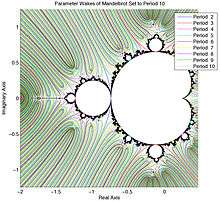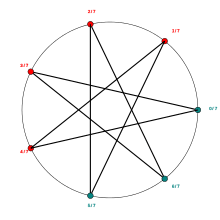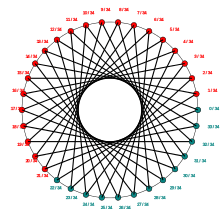How to find the angles of external rays that land on the p/q root point on the boundary of Mandelbrot set's main cardioid ?
First check of p/q is irreducible
 Wakes near the period 1 continent
Wakes near the period 1 continent Wakes_along_the_main_antenna
Wakes_along_the_main_antenna wakes up to period 10
wakes up to period 10
irreducible fraction
/*
gcc i.c -Wall
./a.out
*/
#include <stdio.h>
/*
https://stackoverflow.com/questions/19738919/gcd-function-for-c
The GCD function uses Euclid's Algorithm.
It computes A mod B, then swaps A and B with an XOR swap.
*/
int gcd(int a, int b)
{
int temp;
while (b != 0)
{
temp = a % b;
a = b;
b = temp;
}
return a;
}
int main (){
// internal angle = n/m in turns
int n; // numerator
int d; // denominator
int dMax = 17;
for (d = 2; d <= dMax; ++d )
for (n = 1; n < d; ++n )
if (gcd(n,d)==1 ){
printf("n/d = %d/%d\n", n,d); // irreducible fraction
}
return 0;
}
Output:
n/d = 1/2 n/d = 1/3 n/d = 2/3 n/d = 1/4 n/d = 3/4 n/d = 1/5 n/d = 2/5 n/d = 3/5 n/d = 4/5 n/d = 1/6 n/d = 5/6 n/d = 1/7 n/d = 2/7 n/d = 3/7 n/d = 4/7 n/d = 5/7 n/d = 6/7 n/d = 1/8 n/d = 3/8 n/d = 5/8 n/d = 7/8 n/d = 1/9 n/d = 2/9 n/d = 4/9 n/d = 5/9 n/d = 7/9 n/d = 8/9 n/d = 1/10 n/d = 3/10 n/d = 7/10 n/d = 9/10 n/d = 1/11 n/d = 2/11 n/d = 3/11 n/d = 4/11 n/d = 5/11 n/d = 6/11 n/d = 7/11 n/d = 8/11 n/d = 9/11 n/d = 10/11 n/d = 1/12 n/d = 5/12 n/d = 7/12 n/d = 11/12 n/d = 1/13 n/d = 2/13 n/d = 3/13 n/d = 4/13 n/d = 5/13 n/d = 6/13 n/d = 7/13 n/d = 8/13 n/d = 9/13 n/d = 10/13 n/d = 11/13 n/d = 12/13 n/d = 1/14 n/d = 3/14 n/d = 5/14 n/d = 9/14 n/d = 11/14 n/d = 13/14 n/d = 1/15 n/d = 2/15 n/d = 4/15 n/d = 7/15 n/d = 8/15 n/d = 11/15 n/d = 13/15 n/d = 14/15 n/d = 1/16 n/d = 3/16 n/d = 5/16 n/d = 7/16 n/d = 9/16 n/d = 11/16 n/d = 13/16 n/d = 15/16 n/d = 1/17 n/d = 2/17 n/d = 3/17 n/d = 4/17 n/d = 5/17 n/d = 6/17 n/d = 7/17 n/d = 8/17 n/d = 9/17 n/d = 10/17 n/d = 11/17 n/d = 12/17 n/d = 13/17 n/d = 14/17 n/d = 15/17 n/d = 16/17
notes
external angles of p/q-wake:
- have period q under doubling map. It is the same as period of landing point ( = root point )
- length of periodic part of binary expansion is q
- preperiod under doubling map is zero
"Roots are landing points of parameter rays with periodic angles, while Misiurewicz points have preperiodic external angles." Wolf Jung
Combinatorial algorithm = Devaney's method
Devaney's method[1] for finding external angles of primary buds[2][3]
Steps :
- start with rational rotation angle,
- orbit of rotation angle under circle map
- translation of orbit into itinerary
- conversion of itinerary into binary expansion with repeating binary fraction
- conversion of binary expansion to binary fraction
- conversion to decimal fraction
Input : rational rotation angle
Outpout : external angle ( decimal or binary fraction )
The code
C++
Here is C++ code from the program Mandel by Wolf Jung :
// mndcombi.cpp by Wolf Jung (C) 2007-2015, part of Mandel 5.13,
qulonglong mndAngle::wake(int k, int r, qulonglong &n)
{ if (k <= 0 || k >= r || r > 64) return 0LL;
qulonglong d = 1LL;
int j, s = 0;
n = 1LL;
for (j = 1; j < r; j++)
{ s -= k; if (s < 0) s += r; if (!s) return 0LL;
if (s > r - k) n += d << j;
}
//
d <<= (r - 1); d--; d <<= 1; d++; //2^r - 1 for r <= 64
return d;
}
C GMP and MPFR
/*
------- Git -----------------
cd existing_folder
git init
git remote add origin git@gitlab.com:adammajewski/wake_gmp.git
git add .
git commit -m ""
git push -u origin master
-------------------------------
?? http://stackoverflow.com/questions/2380415/how-to-cut-a-mpz-t-into-two-parts-using-gmp-lib-on-c
to compile from console:
gcc w.c -lgmp -lmpfr -Wall
to run from console :
./a.out
tested on Ubuntu 14.04 LTS
uiIADenominator = 89
Using MPFR-3.1.2-p3 with GMP-5.1.3 with precision = 200 bits
internal angle = 34/89
first external angle :
period = denominator of internal angle = 89
external angle as a decimal fraction = 179622968672387565806504265/618970019642690137449562111 = 179622968672387565806504265 /( 2^89 - 1)
External Angle as a floating point decimal number = 2.9019655713870868535821260055542440298749779423213948304299730531995503353103626302473331181359966368582651105245850405837027542373052381532777325121338632071561064451614697645709384232759475708007812e-1
external angle as a binary rational (string) : 1001010010010100101001001010010010100101001001010010100100101001001010010100100101001001/11111111111111111111111111111111111111111111111111111111111111111111111111111111111111111
external angle as a binary floating number in exponential form =0.10010100100101001010010010100100101001010010010100101001001010010010100101001001010010010100101001001010010100100101001001010010100100101001010010010100100101001010010010100100101001010010010100101001*2^-1
external angle as a binary floating number in periodic form =0.(01001010010010100101001001010010010100101001001010010100100101001001010010100100101001001)
.(01001010010010100101001001010010010100101001001010010100100101001001010010100100101001001)
*/
#include <stdlib.h> // malloc
#include <stdio.h>
#include <gmp.h> // for rational numbers
#include <mpfr.h> // for floating point mumbers
// rotation map
//the number n is always increased by n0 modulo d
// input : op = n/d ( rational number ) and n0 ( integer)
// n = (n + n0 ) % d
// d = d
// output = rop = n/d
void mpq_rotation(mpq_t rop, const mpq_t op, const mpz_t n0)
{
mpz_t n; // numerator
mpz_t d; // denominator
mpz_inits( n, d, NULL);
//
mpq_get_num (n, op); //
mpq_get_den (d, op);
// n = (n + n0 ) % d
mpz_add(n, n, n0);
mpz_mod( n, n, d);
// output
mpq_set_num(rop, n);
mpq_set_den(rop, d);
mpz_clears( n, d, NULL);
}
void mpq_wake(mpq_t rop, mpq_t op)
{
// arbitrary precision variables from GMP library
mpz_t n0 ; // numerator of q
mpz_t nc;
mpz_t n;
mpz_t d ; // denominator of q
mpz_t m; // 2^i
mpz_t num ; // numerator of rop
mpz_t den ; // denominator of rop
long long int i;
unsigned long int base = 2;
unsigned long int id;
int cmp;
mpz_inits(n, n0,nc,d,num,den,m, NULL);
mpq_get_num(n0,op);
mpq_get_den(d,op);
id = mpz_get_ui(d);
// if (n <= 0 || n >= d ) error !!!! bad input
mpz_sub(nc, d, n0); // nc = d - n0
mpz_set(n, n0);
mpz_set_ui(num, 0);
// rop
// num = numerator(rop)
// denominator = den(rop) = (2^i) -1
mpz_ui_pow_ui(den, base, id) ; // den = base^id
mpz_sub_ui(den, den, 1); // den = den-1
// numerator
for (i=0; i<id ; i++){
mpz_set_ui(m, 0);
cmp = mpz_cmp(n,nc);// Compare op1 and op2. Return a positive value if op1 > op2, zero if op1 = op2, or a negative value if op1 < op2.
if ( cmp>0 ) {
mpz_ui_pow_ui(m, 2, id-i-1); // m = 2^(id-i )
mpz_add(num, num, m); // num = num + m
if (mpz_cmp(num, den) >0) mpz_mod( num, num, den); // num = num % d ; if num==d gives 0
//gmp_printf("s = 1");
}
// else gmp_printf("s = 0");
//gmp_printf (" i = %ld internal angle = %Zd / %Zd ea = %Zd / %Zd ; m = %Zd \n", i, n, d, num, den, m);
// n = (n + n0 ) % d = rotation
mpz_add(n, n, n0);
if (mpz_cmp(n, d)>0) mpz_mod( n, n, d);
//
//
}
// rop = external angle
mpq_set_num(rop,num);
mpq_set_den(rop,den);
mpq_canonicalize (rop); // It is the responsibility of the user to canonicalize the assigned variable before any arithmetic operations are performed on that variable.
// clear memory
mpz_clears(n, n0, nc, d, num,den, m, NULL);
}
/*
http://stackoverflow.com/questions/9895216/remove-character-from-string-in-c
"The idea is to keep a separate read and write pointers (pr for reading and pw for writing),
always advance the reading pointer, and advance the writing pointer only when it's not pointing to a given character."
modified
remove first length2rmv chars and after that take only length2stay chars from input string
output = input string
*/
void extract_str(char* str, unsigned int length2rmv, unsigned long int length2stay) {
// separate read and write pointers
char *pr = str; // read pointer
char *pw = str; // write pointer
int i =0; // index
while (*pr) {
if (i>length2rmv-1 && i <length2rmv+length2stay)
pw += 1; // advance the writing pointer only when
pr += 1; // always advance the reading pointer
*pw = *pr;
i +=1;
}
*pw = '\0';
}
int main ()
{
// notation :
//number type : s = string ; q = rational ; z = integer, f = floating point
// base : b = binary ; d = decimal
char *sqdInternalAngle = "13/34";
mpq_t qdInternalAngle; // internal angle = rational number q = n/d
mpz_t den;
unsigned long int uiIADenominator;
mpq_t qdExternalAngle; // rational number q = n/d
char *sqbExternalAngle;
mpfr_t fdExternalAngle ; //
char *sfbExternalAngle; //
mp_exp_t exponent ; // holds the exponent for the result string
mpz_t zdEANumerator;
mpz_t zdEADenominator;
mpfr_t EANumerator;
mpfr_t EADenominator;
mpfr_prec_t p = 200; // in bits , should be > denominator of internal angle
mpfr_set_default_prec (p); // but previously initialized variables are unaffected.
//mpfr_set_default_prec (precision);
// init variables
//mpf_init(fdExternalAngle);
mpz_inits(den, zdEANumerator,zdEADenominator, NULL);
mpq_inits (qdExternalAngle, qdInternalAngle, NULL); //
mpfr_inits(fdExternalAngle, EANumerator, EADenominator, NULL);
// set variables
mpq_set_str(qdInternalAngle, sqdInternalAngle, 10); // string is an internal angle
mpq_canonicalize (qdInternalAngle); // It is the responsibility of the user to canonicalize the assigned variable before any arithmetic operations are performed on that variable.
mpq_get_den(den,qdInternalAngle);
uiIADenominator = mpz_get_ui(den);
printf("uiIADenominator = %lu \n", uiIADenominator);
if ( p < uiIADenominator) printf("increase precision !!!!\n");
mpfr_printf("Using MPFR-%s with GMP-%s with precision = %u bits \n", mpfr_version, gmp_version, (unsigned int) p);
//
mpq_wake(qdExternalAngle, qdInternalAngle); // internal -> external
mpq_get_num(zdEANumerator ,qdExternalAngle);
mpq_get_den(zdEADenominator,qdExternalAngle);
// conversions
mpfr_set_z (EANumerator, zdEANumerator, GMP_RNDN);
mpfr_set_z (EADenominator, zdEADenominator, GMP_RNDN);
sqbExternalAngle = mpq_get_str (NULL, 2, qdExternalAngle); // rational number = fraction : from decimal to binary
mpfr_div (fdExternalAngle, EANumerator, EADenominator, GMP_RNDN);
sfbExternalAngle = (char*)malloc((sizeof(char) * uiIADenominator*2*4) + 3);
// mpfr_get_str (char *str, mpfr_exp_t *expptr, int b, size_t n, mpfr_t op, mpfr_rnd_t rnd)
if (sfbExternalAngle==NULL ) {printf("sfbExternalAngle error \n"); return 1;}
mpfr_get_str(sfbExternalAngle, &exponent, 2,200, fdExternalAngle, GMP_RNDN);
// print
gmp_printf ("internal angle = %Qd\n", qdInternalAngle); //
printf("first external angle : \n");
gmp_printf ("period = denominator of internal angle = %Zd\n", den); //
gmp_printf ("external angle as a decimal fraction = %Qd = %Zd /( 2^%Zd - 1) \n", qdExternalAngle, zdEANumerator, den); //
printf ("External Angle as a floating point decimal number = ");
mpfr_out_str (stdout, 10, p, fdExternalAngle, MPFR_RNDD); putchar ('\n');
gmp_printf ("external angle as a binary rational (string) : %s \n", sqbExternalAngle); //
printf ("external angle as a binary floating number in exponential form =0.%s*%d^%ld\n", sfbExternalAngle, 2, exponent);
extract_str(sfbExternalAngle, uiIADenominator+exponent, uiIADenominator);
printf ("external angle as a binary floating number in periodic form =0.(%s)\n", sfbExternalAngle);
// clear memory
//mpf_clear(fdExternalAngle);
mpq_clears(qdExternalAngle, qdInternalAngle, NULL);
mpz_clears(den, zdEANumerator, zdEADenominator, NULL);
mpfr_clears(fdExternalAngle, EANumerator, EADenominator, NULL);
free(sfbExternalAngle);
return 0;
}
Examples
1/2
One can check with program Mandel :
The 1/2-wake of the main cardioid is bounded by the parameter rays with the angles 1/3 or p01 and 2/3 or p10 .
1/3
Orbit of rational angle 3/7 ( and position in subintervals):
1 / 3 = 0 2 / 3 = 0 0 / 3 = 1
so intinerary = 001
first external angle = 001 = 1 / 7
One can check it with program Mandel by Wolf Jung : the 1/3-wake of the main cardioid is bounded by the parameter rays with the angles
- 1/7 or p001
- 2/7 or p010
note that
1/7 = 0.(001) = 0.(142857)= 0.1428571428571428571428571428571428571428571428571428571428571428571428571428571428571428571428571428571428571428...
n/5
There are 4 period 5 wakes:
- 1/5
- 2/5
- 3/5
- 4/5
Check it with Mandel by Wolf Jung :
The 1/5-wake of the main cardioid is bounded by the parameter rays with the angles :
- 1/31 or p00001
- 2/31 or p00010
The 4/5-wake of the main cardioid is bounded by the parameter rays with the angles
- 29/31 or p11101
- 30/31 or p11110
n/17
Angled internal address
One can check it with Mandel by Wolf Jung:
The 1/17-wake of the main cardioid is bounded by the parameter rays with the angles * 1/131071 or p00000000000000001 * 2/131071 or p00000000000000010
- .(00000000000000001)
- .(00000000000000010)
1/25
uiIADenominator = 25 Using MPFR-3.1.5 with GMP-6.1.1 with precision = 200 bits internal angle = 1/25 first external angle : period = denominator of internal angle = 25 external angle as a decimal fraction = 1/33554431 = 1 /( 2^25 - 1) External Angle as a floating point decimal number = 2.9802323275873758669905622896719661257256902970579355078320375103410059138021557873907862143745145987726127630324761942815747600646073471636075786857847163330961076713939572483194617724677755177253857e-8 external angle as a binary rational (string) : 1/1111111111111111111111111 external angle as a binary floating number in exponential form =0.10000000000000000000000001000000000000000000000000100000000000000000000000010000000000000000000000001000000000000000000000000100000000000000000000000010000000000000000000000001000000000000000000000001*2^-24 external angle as a binary floating number in periodic form =0.(0000000000000000000000001)
So 1/25-wake of the main cardioid is bounded by the parameter rays with the angles :
- 0.0000000298 = 1/33554431 = 1 /( 2^25 - 1) = 0.(0000000000000000000000001)
- 0,0000000596 = 2/33554431 = 2 /( 2^25 - 1) = 0.(0000000000000000000000010)
One can check it with Mandel
The angle 1/33554431 or p0000000000000000000000001 has preperiod = 0 and period = 25. The conjugate angle is 2/33554431 or p0000000000000000000000010 . The kneading sequence is AAAAAAAAAAAAAAAAAAAAAAAA* and the internal address is 1-25 . The corresponding parameter rays are landing at the root of a satellite component of period 25. It is bifurcating from period 1. Do you want to draw the rays and to shift c to the corresponding center?
The center is :
c = 0.265278321904606 +0.003712059989878 i period = 25
3/7



Divide interval ( circle):
into 2 subintervals ( lower partition) :
Orbit of rational angle 3/7 ( and position in subintervals):
3 / 7 = 0 6 / 7 = 1 2 / 7 = 0 5 / 7 = 1 1 / 7 = 0 4 / 7 = 0 0 / 7 = 1
So itinerary is :
One can convert it to number :
One can check it with program Mandel by Wolf Jung :
The 3/7-wake of the main cardioid is bounded by the parameter rays with the angles 41/127 or p0101001 and 42/127 or p0101010 .
root point :
c = -0.606356884415893 +0.412399740175787 i
Orbit of 41/127 under doubling map modulo 1 computed with this program ( exponent = 7 and mpz_init_set_ui(n, 41); :
41/127 82/127 37/127 74/127 21/127 42/127 84/127
1/31

The 1/31-wake of the main cardioid
- is bounded by the parameter rays with the angles 1/2147483647 or p0000000000000000000000000000001 and 2/2147483647 or p0000000000000000000000000000010
- root point : c = 0.260025517721190 +0.002060296266000 i
- center c = 0.260025517721190 +0.002060296266000 i
- principal Misiurewicz point c = 0.259995759918769 +0.001610271381965*i
- has preperiod = 31 , period = 1
- is a landing point for 31 external rays
- 2147483649/4611686016279904256 = 0000000000000000000000000000001p0000000000000000000000000000010 = .0000000000000000000000000000001(0000000000000000000000000000010)
- the biggest baby Mandelbrot set has the kneading sequence AAAAAAAAAAAAAAAAAAAAAAAAAAAAAAB* corresponds to the internal address 1-31-32 . The period is 32. The smallest angles are 3/4294967295 = 0.(00000000000000000000000000000011) and 4/4294967295 = 0.(00000000000000000000000000000100)
On the dynamical plane :
- The angle
13/34

Output from program Mandel by Wolf Jung :
The 13/34-wake of the main cardioid is bounded by the parameter rays with the angles 4985538889/17179869183 or p0100101001001010010100100101001001 and 4985538890/17179869183 or p0100101001001010010100100101001010 .
s = 0 i = 0 internal angle = 13 / 34 ea = 0 / 17179869183 ; m = 0 s = 1 i = 1 internal angle = 26 / 34 ea = 4294967296 / 17179869183 ; m = 4294967296 s = 0 i = 2 internal angle = 5 / 34 ea = 4294967296 / 17179869183 ; m = 0 s = 0 i = 3 internal angle = 18 / 34 ea = 4294967296 / 17179869183 ; m = 0 s = 1 i = 4 internal angle = 31 / 34 ea = 4831838208 / 17179869183 ; m = 536870912 s = 0 i = 5 internal angle = 10 / 34 ea = 4831838208 / 17179869183 ; m = 0 s = 1 i = 6 internal angle = 23 / 34 ea = 4966055936 / 17179869183 ; m = 134217728 s = 0 i = 7 internal angle = 2 / 34 ea = 4966055936 / 17179869183 ; m = 0 s = 0 i = 8 internal angle = 15 / 34 ea = 4966055936 / 17179869183 ; m = 0 s = 1 i = 9 internal angle = 28 / 34 ea = 4982833152 / 17179869183 ; m = 16777216 s = 0 i = 10 internal angle = 7 / 34 ea = 4982833152 / 17179869183 ; m = 0 s = 0 i = 11 internal angle = 20 / 34 ea = 4982833152 / 17179869183 ; m = 0 s = 1 i = 12 internal angle = 33 / 34 ea = 4984930304 / 17179869183 ; m = 2097152 s = 0 i = 13 internal angle = 12 / 34 ea = 4984930304 / 17179869183 ; m = 0 s = 1 i = 14 internal angle = 25 / 34 ea = 4985454592 / 17179869183 ; m = 524288 s = 0 i = 15 internal angle = 4 / 34 ea = 4985454592 / 17179869183 ; m = 0 s = 0 i = 16 internal angle = 17 / 34 ea = 4985454592 / 17179869183 ; m = 0 s = 1 i = 17 internal angle = 30 / 34 ea = 4985520128 / 17179869183 ; m = 65536 s = 0 i = 18 internal angle = 9 / 34 ea = 4985520128 / 17179869183 ; m = 0 s = 1 i = 19 internal angle = 22 / 34 ea = 4985536512 / 17179869183 ; m = 16384 s = 0 i = 20 internal angle = 1 / 34 ea = 4985536512 / 17179869183 ; m = 0 s = 0 i = 21 internal angle = 14 / 34 ea = 4985536512 / 17179869183 ; m = 0 s = 1 i = 22 internal angle = 27 / 34 ea = 4985538560 / 17179869183 ; m = 2048 s = 0 i = 23 internal angle = 6 / 34 ea = 4985538560 / 17179869183 ; m = 0 s = 0 i = 24 internal angle = 19 / 34 ea = 4985538560 / 17179869183 ; m = 0 s = 1 i = 25 internal angle = 32 / 34 ea = 4985538816 / 17179869183 ; m = 256 s = 0 i = 26 internal angle = 11 / 34 ea = 4985538816 / 17179869183 ; m = 0 s = 1 i = 27 internal angle = 24 / 34 ea = 4985538880 / 17179869183 ; m = 64 s = 0 i = 28 internal angle = 3 / 34 ea = 4985538880 / 17179869183 ; m = 0 s = 0 i = 29 internal angle = 16 / 34 ea = 4985538880 / 17179869183 ; m = 0 s = 1 i = 30 internal angle = 29 / 34 ea = 4985538888 / 17179869183 ; m = 8 s = 0 i = 31 internal angle = 8 / 34 ea = 4985538888 / 17179869183 ; m = 0 s = 0 i = 32 internal angle = 21 / 34 ea = 4985538888 / 17179869183 ; m = 0 s = 1 i = 33 internal angle = 34 / 34 ea = 4985538889 / 17179869183 ; m = 1 internal angle = 13/34 period = denominator of internal angle = 34 external angle as a decimal fraction = 4985538889/17179869183 = 4985538889 /( 2^34 - 1) external angle as a binary rational (string) : 100101001001010010100100101001001/1111111111111111111111111111111111 external angle as a binary floating number in exponential form =0.1001010010010100101001001010010010100101001001010010100100101001*2^-1 external angle as a binary floating number in periodic form =0.(0100101001001010010100100101001)
34/89
Using GMP-5.1.3 with precision = 256 bits internal angle = 34/89 period = denominator of internal angle = 89 external angle as a decimal fraction = 179622968672387565806504265/618970019642690137449562111 external angle as a binary rational (string) : 1001010010010100101001001010010010100101001001010010100100101001001010010100100101001001/11111111111111111111111111111111111111111111111111111111111111111111111111111111111111111 external angle as a binary floating number in exponential form =0.10010100100101001010010010100100101001010010010100101001001010010010100101001001010010010100101001001010010100100101001001010010100100101001010010010100100101001010010010100100101001010010010100101001001010010010100101001001010010100100101001001010010100101*2^-1 external angle as a binary floating number in periodic form =0.(01001010010010100101001001010010010100101001001010010100100101001001010010100100101001001)
89/268

Using GMP-5.1.3 with precision = 320 bits internal angle = 89/268 period = denominator of internal angle = 268 external angle as a decimal fraction = 67754913930863876636420964942226524366713408170066250043659752013773168429311121/474284397516047136454946754595585670566993857190463750305618264096412179005177855 external angle as a binary rational (string) : 0010010010010010010010010010010010010010010010010010010010010010010010010010010010010010010010010010010010010010010010010010010010010010010010010010010010010010010010010010010010010010010010010010010010010010010010010010010010010010010010010010010010010010010010001 /1111111111111111111111111111111111111111111111111111111111111111111111111111111111111111111111111111111111111111111111111111111111111111111111111111111111111111111111111111111111111111111111111111111111111111111111111111111111111111111111111111111111111111111111111111 external angle as a binary floating number in exponential form =0.10010010010010010010010010010010010010010010010010010010010010010010010010010010010010010010010010010010010010010010010010010010010010010010010010010010010010010010010010010010010010010010010010010010010010010010010010010010010010010010010010010010010010010010010001 001001001001001001001001001001001001001001001001001001*2^-2 external angle as a binary floating number in periodic form = 0.(0010010010010010010010010010010010010010010010010010010010010010010010010010010010010010010010010010010010010010010010010010010010010010010010010010010010010010010010010010010010010010010010010010010010010010010010010010010010010010010010010010010010010010010010010001)